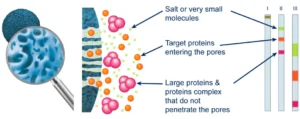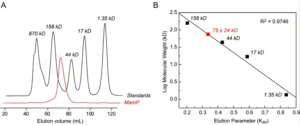Size Exclusion Chromatography
In size exclusion chromatography ( molecular or gel filtration or gel permeation chromatography), molecules, and particles are separated. Small molecules penetrate the pores of the stationary phase, but large molecules do not. Because small molecules must pass through an effectively larger volume, large molecules are eluted first. This technique is widely used in biochemistry to purify macromolecules.
Principal :
Size exclusion chromatography (SEC) separates particles based on size by filtration process through a gel. The gel consists of spherical beads containing pores of a specific size distribution. Separation occurs when molecules of different sizes are included or excluded from the pores within the matrix.
Components of Chromatography:
A size-exclusion column comprises a stationary phase of porous particles all packed together into a column. Like most chromatography columns, it must be kept hydrated at all times. The porous particles are usually made of an inert polymer such as agarose, cellulose, or dextran.
Buffer; A solution that resists changes in pH when alkali or acid substances are added. It prevents reaction from changes.
Applications of size exclusion chromatography
Size exclusion chromatography (SEC) is commonly used for the separation and molecular weight (MW) determination of polymers, peptide proteins, fractionation of proteins, and other water-soluble polymers.
Void volume in size exclusion chromatography
The void volume in SEC is the volume of the mobile phase required to elute a molecule with zero retention in the stationary phase. In an ideal case, it is equal to the volume of the mobile phase in a column, which is the volume of the pores and spaces between the stationary phase.
Retention time: The time required to sample from injection to elution from solution.
Difference between Gel Filtration and Gel Permeation:
Gel filtration: usually refers to a hydrophilic stationary phase and aqueous eluent.
Gel permeation: usually refers to a hydrophobic stationary phase and organic eluent.

- Large molecules cannot penetrate the pores of the stationary phase. A volume of solvent equal to the volume of the mobile phase elutes them. Small molecules, which can be found inside or outside the gel, require a larger volume for elution. Vt is the total column volume occupied by gel plus solvent. Vo is the volume of solvent outside the gel particles. Vm is the total volume of solvent inside and outside the gel particles.
- In pure molecular exclusion, all molecules are eluted between Kav = 0 and Kav =1
Properties and nature of the gel
The gel should be:
1. Chemically inert
2. Mechanically stable
3. Has ideal and homogeneous porous structure (wide pore size results in low resolution)
4. Uniform particle and pore size.
5- The pore size of the gel must be carefully controlled (via the degree of crosslinking).
According to the swelling process, the gels are two types:
1- Soft gels(Xerogel, is gel only on swelling) e.g. Polyacrylamide gels, dextran, or agarose
(used for separate proteins in the aqueous mobile phase).
2- Semirigid or rigid gels (aerogel, is gel in the air)
1) Polystyrene gels (separation of non-polar polymers in non-polar solvents).
2) Porous glass gels (separation of polar systems)
Eluent
The eluent (mobile phase) should be a good solvent for the polymer.
- The solvent must be able to dissolve the sample, sometimes a polymer insoluble at room temperature will dissolve at higher temperature.
- The solvent must not induce any interactions between the sample and the stationary phase. The separation is solely based on sample size.
- It should permit a high detector response from the polymer and wet the packing surface. It may also buffer.
- The solvent container should be made of clear glass, or amber glass for solvents affected by sunlight, with a stopper to exclude dust and limit evaporation.
Separation procedures
1- Preparation of column for gel filtration
Swelling of the gel: some resin come in a powder form, these must be sonicated first in the eluent or the desired buffer to swell.
Packing the column: make a slurry of gel plus buffer and pour it into the column which is one-third filled with the buffer.
Washing the resin: after packing, pass several column volumes of the buffer through the column to remove any air bubbles and to test the column homogeneity.
2- Load the sample onto the column: the sample must enter the resin in solution
using a syringe.
3- eluting the sample and detecting components: Fractions are collected as the sample
elutes from the column.

It may be represented by graphs shown in the figure according to their separation and size.

